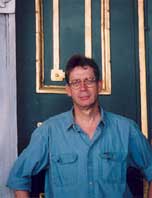

|
Richard W. Tillinghast Professor of English, director U-M Bear River Writers' Conference
In 1954, Richard Tillinghast was 14 years old, and in his last year of junior high at Fairview School in Memphis. "Segregation was more or less total in Memphis in the '50s," says Tillinghast, a prominent poet and professor of English, and no Black families lived anywhere near his home. "My family was not wealthy," he says, "but we always had a Black maid/cook and yard man, and our house had separate toilet facilities for them at the back of the house. Once I started driving, I would sometimes drive our maid, Elizabeth Porter, home. And at age 16 I felt as if I was making a statement when I asked her to ride up in front with me as we drove. This seemed a little radical to her as well." A funny suggestion But as a child, Tillinghast says, he "didn't understand segregation at all. On our family farm I often went out into the fields with the workers, as a kind of little mascot. I enjoyed riding the farm machinery, talking with the Black field hands, sharing the simple meals and jars of cold well-water they took with them to work in the west Tennessee sun. I used to try to get my uncle and aunt, who owned the farm, to invite a Black couple to dinner. They thought my suggestion was the funniest thing they had ever heard-not threatening or radical, just hilariously funny." Tillinghast says he played with Black children on the farm but not in the city. "When the Court's decision was announced," Tillinghast recalls, "people were immediately aware that it was significant. The papers were full of it, and my civics teacher devoted many classes to the subject. As a teenager it was clear to me that something significant and historical had happened. Most of the people I knew were horrified. My school was not integrated." Ignoring Brown, Memphis public schools, with a school-age population that was 50-50 white and Black, were still fully segregated in 1960 when the NAACP Legal Defense and Education Fund sued to force the issue. By 1962, a small cadre of Black first-graders enrolled in all-white schools, and by 1967, all grade school classrooms were desegregated, even if mostly only to a token degree. Ultimately, the schools were integrated with the use of court-ordered busing in 1973, but by then the school-age white population had substantially vacated the city, leaving for the de facto segregated suburbs surrounding Memphis in Shelby County. The changes in the South did not become a reality for him, Tillinghast says, until he went away to college in 1958. "There," he continues, "I joined 'the Movement' and helped integrate my college, the University of the South, known as Sewanee. The first Black peers I made friends with were in college, through the Movement, and when I was 20 and went to Europe, I became friends with African students from Sierra Leone who were studying in Italy. Jazz was a common ground "As a member of the Sewanee Jazz Society, I helped bring musicians such as the Modern Jazz Quartet and Louis Armstrong to campus, and because there were no integrated facilities available for the musicians to stay, they stayed in the homes of faculty members. It's ironic that some of the first serious conversations I ever had with a Black person were with Percy Heath, the bass player in the MJQ. He was very warm and must have enjoyed my naiveté and enthusiasm. Later, we had sit-ins to desegregate the college-run motel and restaurant. The transition was very smooth and nonviolent, but not unopposed. The vice-chancellor or president of our college refused to let us invite Pete Seeger to sing on campus, because he was 'a Communist.'" Sewanee, n the Cumberland Mountains near Chattanooga, and is near the Highlander Folk School run by the civil rights pioneer Myles Horton. "I began spending a lot of my time at Highlander," Tillinghast says. "I met John Lewis and other civil rights activists there, and I participated in sit-ins and demonstrations in Chattanooga and Atlanta. We faced hostility from some of our more backward-thinking classmates, and the more predictable slurs were directed at us, such as 'Nigger lover,' which I can recall hearing a few people mutter under their breath as they passed me on campus." On the whole, however, Tillinghast remembers "an atmosphere not of threat or danger but of excitement, because we were helping something new happen in American society." |Adye
Bel Evans|
B.J. Evans
|

![]()
